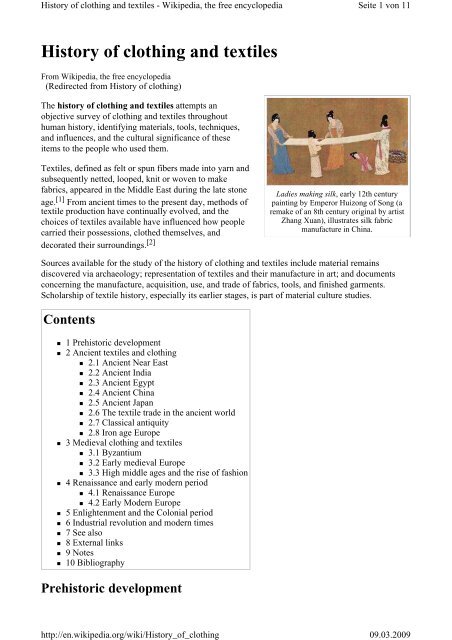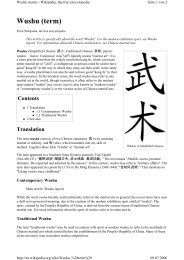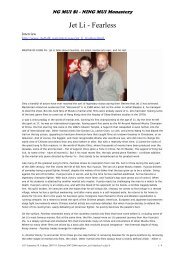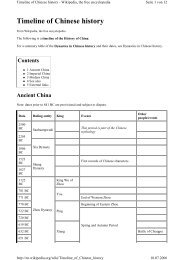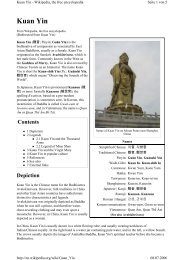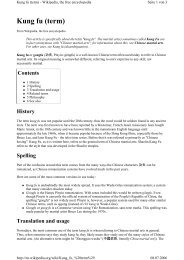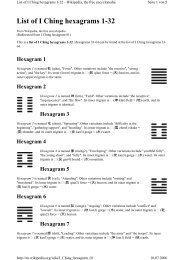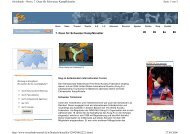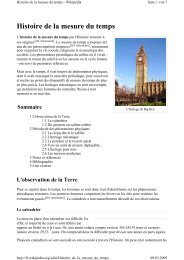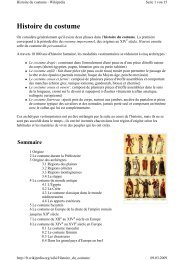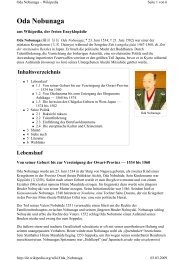You also want an ePaper? Increase the reach of your titles
YUMPU automatically turns print PDFs into web optimized ePapers that Google loves.
<strong>History</strong> <strong>of</strong> <strong>clothing</strong> <strong>and</strong> <strong>textiles</strong> - Wikipedia, the free encyclopedia<br />
<strong>History</strong> <strong>of</strong> <strong>clothing</strong> <strong>and</strong> <strong>textiles</strong><br />
From Wikipedia, the free encyclopedia<br />
(Redirected from <strong>History</strong> <strong>of</strong> <strong>clothing</strong>)<br />
The history <strong>of</strong> <strong>clothing</strong> <strong>and</strong> <strong>textiles</strong> attempts an<br />
objective survey <strong>of</strong> <strong>clothing</strong> <strong>and</strong> <strong>textiles</strong> throughout<br />
human history, identifying materials, tools, techniques,<br />
<strong>and</strong> influences, <strong>and</strong> the cultural significance <strong>of</strong> these<br />
items to the people who used them.<br />
Textiles, defined as felt or spun fibers made into yarn <strong>and</strong><br />
subsequently netted, looped, knit or woven to make<br />
fabrics, appeared in the Middle East during the late stone<br />
age. [1] From ancient times to the present day, methods <strong>of</strong><br />
textile production have continually evolved, <strong>and</strong> the<br />
choices <strong>of</strong> <strong>textiles</strong> available have influenced how people<br />
carried their possessions, clothed themselves, <strong>and</strong><br />
decorated their surroundings. [2]<br />
Sources available for the study <strong>of</strong> the history <strong>of</strong> <strong>clothing</strong> <strong>and</strong> <strong>textiles</strong> include material remains<br />
discovered via archaeology; representation <strong>of</strong> <strong>textiles</strong> <strong>and</strong> their manufacture in art; <strong>and</strong> documents<br />
concerning the manufacture, acquisition, use, <strong>and</strong> trade <strong>of</strong> fabrics, tools, <strong>and</strong> finished garments.<br />
Scholarship <strong>of</strong> textile history, especially its earlier stages, is part <strong>of</strong> material culture studies.<br />
Contents<br />
� 1 Prehistoric development<br />
� 2 Ancient <strong>textiles</strong> <strong>and</strong> <strong>clothing</strong><br />
� 2.1 Ancient Near East<br />
� 2.2 Ancient India<br />
� 2.3 Ancient Egypt<br />
� 2.4 Ancient China<br />
� 2.5 Ancient Japan<br />
� 2.6 The textile trade in the ancient world<br />
� 2.7 Classical antiquity<br />
� 2.8 Iron age Europe<br />
� 3 Medieval <strong>clothing</strong> <strong>and</strong> <strong>textiles</strong><br />
� 3.1 Byzantium<br />
� 3.2 Early medieval Europe<br />
� 3.3 High middle ages <strong>and</strong> the rise <strong>of</strong> fashion<br />
� 4 Renaissance <strong>and</strong> early modern period<br />
� 4.1 Renaissance Europe<br />
� 4.2 Early Modern Europe<br />
� 5 Enlightenment <strong>and</strong> the Colonial period<br />
� 6 Industrial revolution <strong>and</strong> modern times<br />
� 7 See also<br />
� 8 External links<br />
� 9 Notes<br />
� 10 Bibliography<br />
Prehistoric development<br />
http://en.wikipedia.org/wiki/<strong>History</strong>_<strong>of</strong>_<strong>clothing</strong><br />
Seite 1 von 11<br />
Ladies making silk, early 12th century<br />
painting by Emperor Huizong <strong>of</strong> Song (a<br />
remake <strong>of</strong> an 8th century original by artist<br />
Zhang Xuan), illustrates silk fabric<br />
manufacture in China.<br />
09.03.2009
<strong>History</strong> <strong>of</strong> <strong>clothing</strong> <strong>and</strong> <strong>textiles</strong> - Wikipedia, the free encyclopedia<br />
Interest in prehistoric developments <strong>of</strong> textile <strong>and</strong> <strong>clothing</strong> manufacture has resulted in a number <strong>of</strong><br />
scholarly studies since the late twentieth century, including Prehistoric Textiles: The Development <strong>of</strong><br />
Cloth in the Neolithic <strong>and</strong> Bronze Ages with Special Reference to the Aegean, [3] as well as Women's<br />
Work: The First 20,000 Years: Women, Cloth, <strong>and</strong> Society in Early Times. [4] These sources have<br />
helped to provide a coherent history <strong>of</strong> these prehistoric developments. Evidence suggests that human<br />
beings may have begun wearing <strong>clothing</strong> as far back as 100,000 to 500,000 years ago. [5]<br />
Genetic analysis suggests that the human body louse, which lives in <strong>clothing</strong>, may have diverged<br />
from the head louse some 107,000 years ago, evidence that humans began wearing <strong>clothing</strong> at around<br />
this time. [6]<br />
Possible sewing needles have been dated to around 40,000 years ago. [7] The earliest definite<br />
examples <strong>of</strong> needles originate from the Solutrean culture, which existed in France from 19,000 BC to<br />
15,000 BC.<br />
The earliest evidence <strong>of</strong> weaving comes from impressions <strong>of</strong> <strong>textiles</strong> <strong>and</strong> basketry <strong>and</strong> nets on little<br />
pieces <strong>of</strong> hard clay, dating from 27,000 years ago <strong>and</strong> found in the Czech Republic.<br />
At a slightly later date (25,000 years) the Venus figurines were depicted with <strong>clothing</strong>. [8] Those from<br />
western Europe were adorned with basket hats or caps, belts worn at the waist, <strong>and</strong> a strap <strong>of</strong> cloth<br />
that wrapped around the body right above the breast. Eastern European figurines wore belts, hung low<br />
on the hips <strong>and</strong> sometimes string skirts. [9]<br />
Archaeologists have discovered artifacts from the same period that appear to have been used in the<br />
textile arts: net gauges, spindle needles <strong>and</strong> weaving sticks. [10]<br />
Ancient <strong>textiles</strong> <strong>and</strong> <strong>clothing</strong><br />
The first actual textile, as opposed to skins sewn together, was probably felt. Surviving examples <strong>of</strong><br />
Nålebinding, another early textile method, date from 6500 BCE. Our knowledge <strong>of</strong> ancient <strong>textiles</strong><br />
<strong>and</strong> <strong>clothing</strong> has exp<strong>and</strong>ed in the recent past thanks to modern technological developments. [11] Our<br />
knowledge <strong>of</strong> cultures varies greatly with the climatic conditions to which archeological deposits are<br />
exposed; the Middle East <strong>and</strong> the arid fringes <strong>of</strong> China have provided many very early samples in<br />
good condition, but the early development <strong>of</strong> <strong>textiles</strong> in the Indian subcontinent, sub-Saharan Africa<br />
<strong>and</strong> other moist parts <strong>of</strong> the world remains unclear. In northern Eurasia peat bogs can also preserve<br />
<strong>textiles</strong> very well.<br />
Early woven <strong>clothing</strong> was <strong>of</strong>ten made <strong>of</strong> full loom widths draped, tied, or pinned in place.<br />
Ancient Near East<br />
The earliest known woven <strong>textiles</strong> <strong>of</strong> the Near East may be fabrics used to wrap the dead excavated at<br />
a Neolithic site at Airiel in Anatolia, carbonized in a fire <strong>and</strong> radiocarbon dated to c. 6000 BC. [12]<br />
Flax cultivation is evidenced from c. 8000 BC in the Near East, but the breeding <strong>of</strong> sheep with a<br />
wooly fleece rather than hair occurs much later, c. 3000 BC [12]<br />
But Çayönü in Turkey has also been claimed as the site <strong>of</strong> the oldest known cloth, a piece <strong>of</strong> woven<br />
linen wrapped around an antler <strong>and</strong> reported to be from around 7000 BCE.<br />
Ancient India<br />
http://en.wikipedia.org/wiki/<strong>History</strong>_<strong>of</strong>_<strong>clothing</strong><br />
Seite 2 von 11<br />
09.03.2009
<strong>History</strong> <strong>of</strong> <strong>clothing</strong> <strong>and</strong> <strong>textiles</strong> - Wikipedia, the free encyclopedia<br />
The inhabitants <strong>of</strong> the Indus Valley Civilization used cotton for <strong>clothing</strong> as early as the 5th<br />
millennium BCE - 4th millennium BCE. [13]<br />
According to The Columbia Encyclopedia, Sixth Edition: [14]<br />
"Cotton has been spun, woven, <strong>and</strong> dyed since prehistoric times. It clothed the people <strong>of</strong> ancient<br />
India, Egypt, <strong>and</strong> China. Hundreds <strong>of</strong> years before the Christian era cotton <strong>textiles</strong> were woven in<br />
India with matchless skill, <strong>and</strong> their use spread to the Mediterranean countries. In the 1st cent. Arab<br />
traders brought fine muslin <strong>and</strong> calico to Italy <strong>and</strong> Spain. The Moors introduced the cultivation <strong>of</strong><br />
cotton into Spain in the 9th cent. Fustians <strong>and</strong> dimities were woven there <strong>and</strong> in the 14th cent. in<br />
Venice <strong>and</strong> Milan, at first with a linen warp. Little cotton cloth was imported to Engl<strong>and</strong> before the<br />
15th cent., although small amounts were obtained chiefly for c<strong>and</strong>lewicks. By the 17th cent. the East<br />
India Company was bringing rare fabrics from India. Native Americans skillfully spun <strong>and</strong> wove<br />
cotton into fine garments <strong>and</strong> dyed tapestries. Cotton fabrics found in Peruvian tombs are said to<br />
belong to a pre-Inca culture. In color <strong>and</strong> texture the ancient Peruvian <strong>and</strong> Mexican <strong>textiles</strong> resemble<br />
those found in Egyptian tombs."<br />
Ancient Egypt<br />
Evidence exists for production <strong>of</strong> linen cloth in Ancient Egypt in<br />
the Neolithic period, c. 5500 BC. Cultivation <strong>of</strong> domesticated<br />
wild flax, probably an import from the Levant, is documented as<br />
early as c. 6000 BC Other bast fibers including rush, reed, palm,<br />
<strong>and</strong> papyrus were used alone or with linen to make rope <strong>and</strong> other<br />
<strong>textiles</strong>. Evidence for wool production in Egypt is scanty at this<br />
period. [15] .<br />
Spinning techniques included the drop spindle, h<strong>and</strong>-to-h<strong>and</strong><br />
spinning, <strong>and</strong> rolling on the thigh; yarn was also spliced. [15] . A<br />
horizontal ground loom was used prior to the New Kingdom,<br />
when a vertical two-beam loom was introduced, probably from<br />
Asia.<br />
Linen b<strong>and</strong>ages were used in the burial custom <strong>of</strong><br />
mummification, <strong>and</strong> art depicts Egyptian men wearing linen kilts<br />
<strong>and</strong> women in narrow dresses with various forms <strong>of</strong> shirts <strong>and</strong><br />
jackets, <strong>of</strong>ten <strong>of</strong> sheer pleated fabric. [15]<br />
Ancient China<br />
The earliest evidence <strong>of</strong> silk production in China was found at the<br />
sites <strong>of</strong> Yangshao culture in Xia, Shanxi, where a cocoon <strong>of</strong><br />
bombyx mori, the domesticated silkworm, cut in half by a sharp<br />
knife is dated to between 5000 <strong>and</strong> 3000 BC. Fragments <strong>of</strong><br />
primitive looms are also seen from the sites <strong>of</strong> Hemudu culture in<br />
Yuyao, Zhejiang, dated to about 4000 BC. Scraps <strong>of</strong> silk were<br />
found in a Liangzhu culture site at Qianshanyang in Huzhou,<br />
Zhejiang, dating back to 2700 BC. [16][17] Other fragments have<br />
been recovered from royal tombs in the Shang Dynasty (ca. 1600<br />
BC - c. 1046 BC). [18]<br />
Under the Shang Dynasty, Han Chinese <strong>clothing</strong> or Hanfu<br />
http://en.wikipedia.org/wiki/<strong>History</strong>_<strong>of</strong>_<strong>clothing</strong><br />
Seite 3 von 11<br />
Queen Nefertari in a sheer,<br />
pleated linen garment, Egypt, c.<br />
1298-1235 BC<br />
Woven silk textile from tombs at<br />
Mawangdui, Changsha, Hunan<br />
province, China, from the<br />
Western Han Dynasty, 2nd<br />
century BC<br />
09.03.2009
<strong>History</strong> <strong>of</strong> <strong>clothing</strong> <strong>and</strong> <strong>textiles</strong> - Wikipedia, the free encyclopedia<br />
consisted <strong>of</strong> a yi, a narrow-cuffed, knee-length tunic tied with a sash, <strong>and</strong> a narrow, ankle-length skirt,<br />
called shang, worn with a bixi, a length <strong>of</strong> fabric that reached the knees. Clothing <strong>of</strong> the elite was<br />
made <strong>of</strong> silk in vivid primary colours.<br />
Ancient Japan<br />
The earliest evidence <strong>of</strong> weaving in Japan is associated with the Yayoi period (弥生時代 Yayoijidai)<br />
, from about 300 BC to 250.<br />
The textile trade in the ancient world<br />
The exchange <strong>of</strong> luxury <strong>textiles</strong> was predominant on the Silk Road, a series <strong>of</strong> ancient trade <strong>and</strong><br />
cultural transmission routes that were central to cultural interaction through regions <strong>of</strong> the Asian<br />
continent connecting East <strong>and</strong> West by linking traders, merchants, pilgrims, monks, soldiers, nomads<br />
<strong>and</strong> urban dwellers from China to the Mediterranean Sea during various periods <strong>of</strong> time. The trade<br />
route was initiated around 114 BC by the Han Dynasty, [19] although earlier trade across the<br />
continents had already existed. Geographically, the Silk Road or Silk Route is an interconnected<br />
series <strong>of</strong> ancient trade routes between Chang'an (today's Xi'an) in China, with Asia Minor <strong>and</strong> the<br />
Mediterranean extending over 8,000 km (5,000 miles) on l<strong>and</strong> <strong>and</strong> sea. Trade on the Silk Road was a<br />
significant factor in the development <strong>of</strong> the great civilizations <strong>of</strong> China, Egypt, Mesopotamia, Persia,<br />
the Indian subcontinent, <strong>and</strong> Rome, <strong>and</strong> helped to lay the foundations for the modern world.<br />
Classical antiquity<br />
Greek chiton (left) <strong>and</strong> chiton<br />
worn under himation<br />
Dress in classical antiquity favored wide, unsewn lengths <strong>of</strong><br />
fabric, pinned <strong>and</strong> draped to the body in various ways.<br />
Ancient Greek <strong>clothing</strong> consisted <strong>of</strong> lengths <strong>of</strong> wool or linen,<br />
generally rectangular <strong>and</strong> secured at the shoulders with<br />
ornamented pins called fibulae <strong>and</strong> belted with a sash. Typical<br />
garments were the peplos, a loose robe worn by women; the<br />
chlamys, a cloak worn by men; <strong>and</strong> the chiton, a tunic worn by<br />
both men <strong>and</strong> women. Men’s chitons hung to the knees, whereas<br />
women’s chitons fell to their ankles. A long cloak called a<br />
himation was worn over the peplos or chlamys.<br />
The toga <strong>of</strong> ancient Rome was also an unsewn length <strong>of</strong> wool cloth, worn by male citizens draped<br />
around the body in various fashions, over a simple tunic. Early tunics were two simple rectangles<br />
joined at the shoulders <strong>and</strong> sides; later tunics had sewn sleeves. Women wore the draped stola or an<br />
ankle-length tunic, with a shawl-like palla as an outer garment. Wool was the preferred fabic,<br />
although linen, hemp, <strong>and</strong> small amounts <strong>of</strong> expensive imported silk <strong>and</strong> cotton were also worn.<br />
Iron age Europe<br />
Medieval <strong>clothing</strong> <strong>and</strong> <strong>textiles</strong><br />
Seite 4 von 11<br />
The history <strong>of</strong> Medieval European <strong>clothing</strong> <strong>and</strong> <strong>textiles</strong> has inspired a good deal <strong>of</strong> scholarly interest<br />
in the twenty-first century. Elisabeth Crowfoot, Frances Pritchard, <strong>and</strong> Kay Stanil<strong>and</strong> authored<br />
Textiles <strong>and</strong> Clothing: Medieval Finds from Excavations in London, c.1150-c.1450 (Boydell Press,<br />
2001). The topic is also the subject <strong>of</strong> an annual series Medieval Clothing <strong>and</strong> Textiles (Boydell<br />
Press) edited by Robin Netherton <strong>and</strong> Pr<strong>of</strong>essor Gale R. Owen-Crocker <strong>of</strong> Anglo-Saxon Culture at the<br />
http://en.wikipedia.org/wiki/<strong>History</strong>_<strong>of</strong>_<strong>clothing</strong><br />
09.03.2009
<strong>History</strong> <strong>of</strong> <strong>clothing</strong> <strong>and</strong> <strong>textiles</strong> - Wikipedia, the free encyclopedia<br />
University <strong>of</strong> Manchester.<br />
Byzantium<br />
The Byzantines made <strong>and</strong> exported very richly patterned cloth, woven <strong>and</strong> embroidered for the upper<br />
classes, <strong>and</strong> resist-dyed <strong>and</strong> printed for the lower. [20] By Justinian's time the Roman toga had been<br />
replaced by the tunica, or long chiton, for both sexes, over which the upper classes wore various other<br />
garments, like a dalmatica (dalmatic), a heavier <strong>and</strong> shorter type <strong>of</strong> tunica; short <strong>and</strong> long cloaks were<br />
fastened on the right shoulder.<br />
Leggings <strong>and</strong> hose were <strong>of</strong>ten worn, but are not prominent in depictions <strong>of</strong> the wealthy; they were<br />
associated with barbarians, whether European or Persian. [21]<br />
Early medieval Europe<br />
European dress changed gradually in the years 400 to 1100. People in<br />
many countries dressed differently depending on whether they identified<br />
with the old Romanised population, or the new invading populations such<br />
as Franks, Anglo-Saxons, <strong>and</strong> Visigoths. Men <strong>of</strong> the invading peoples<br />
generally wore short tunics, with belts, <strong>and</strong> visible trousers, hose or<br />
leggings. The Romanised populations, <strong>and</strong> the Church, remained faithful<br />
to the longer tunics <strong>of</strong> Roman formal costume. [22]<br />
The elite imported silk cloth from the Byzantine, <strong>and</strong> later Moslem,<br />
worlds, <strong>and</strong> also probably cotton. They also could afford bleached linen<br />
<strong>and</strong> dyed <strong>and</strong> simply patterned wool woven in Europe itself. But<br />
embroidered decoration was probably very widespread, though not<br />
usually detectable in art. Lower classes wore local or homespun wool,<br />
<strong>of</strong>ten undyed, trimmed with b<strong>and</strong>s <strong>of</strong> decoration, variously embroidery,<br />
tablet-woven b<strong>and</strong>s, or colorful borders woven into the fabric in the<br />
loom. [23] . [24]<br />
High middle ages <strong>and</strong> the rise <strong>of</strong> fashion<br />
14th century Italian silk<br />
damasks<br />
Seite 5 von 11<br />
Edgar I <strong>of</strong> Engl<strong>and</strong> in<br />
short tunic, hose, <strong>and</strong><br />
cloak, 966<br />
Clothing in 12th <strong>and</strong> 13th century Europe remained very simple for both<br />
men <strong>and</strong> women, <strong>and</strong> quite uniform across the subcontinent. The<br />
traditional combination <strong>of</strong> short tunic with hose for working-class men<br />
<strong>and</strong> long tunic with overgown for women <strong>and</strong> upper class men remained<br />
the norm. Most <strong>clothing</strong>, especially outside the wealthier classes,<br />
remained little changed from three or four centuries earlier. [25]<br />
The 13th century saw great progress in the dyeing <strong>and</strong> working <strong>of</strong> wool,<br />
which was by far the most important material for outer wear. Linen was<br />
increasingly used for <strong>clothing</strong> that was directly in contact with the skin.<br />
Unlike wool, linen could be laundered <strong>and</strong> bleached in the sun. Cotton,<br />
imported raw from Egypt <strong>and</strong> elsewhere, was used for padding <strong>and</strong><br />
quilting, <strong>and</strong> cloths such as buckram <strong>and</strong> fustian.<br />
Crusaders returning from the Levant brought knowledge <strong>of</strong> its fine<br />
<strong>textiles</strong>, including light silks, to Western Europe. In Northern Europe, silk was an imported <strong>and</strong> very<br />
expensive luxury. [26] The well-<strong>of</strong>f could afford woven brocades from Italy or even further afield.<br />
Fashionable Italian silks <strong>of</strong> this period featured repeating patterns <strong>of</strong> roundels <strong>and</strong> animals, deriving<br />
http://en.wikipedia.org/wiki/<strong>History</strong>_<strong>of</strong>_<strong>clothing</strong><br />
09.03.2009
<strong>History</strong> <strong>of</strong> <strong>clothing</strong> <strong>and</strong> <strong>textiles</strong> - Wikipedia, the free encyclopedia<br />
from Ottoman silk-weaving centres in Bursa, <strong>and</strong> ultimately from Yuan Dynasty China via the Silk<br />
Road. [27]<br />
Cultural <strong>and</strong> costume historians agree that the mid-14th century marks the emergence <strong>of</strong> recognizable<br />
"fashion" in Europe. [28][29] From this century onwards Western fashion changes at a pace quite<br />
unknown to other civilizations, whether ancient or contemporary. [30] In most other cultures only<br />
major political changes, such as the Muslim conquest <strong>of</strong> India, produced radical changes in <strong>clothing</strong>,<br />
<strong>and</strong> in China, Japan, <strong>and</strong> the Ottoman Empire fashion changed only slightly over periods <strong>of</strong> several<br />
centuries. [31]<br />
In this period the draped garments <strong>and</strong> straight seams <strong>of</strong> previous centuries were replaced by curved<br />
seams <strong>and</strong> the beginnings <strong>of</strong> tailoring, which allowed <strong>clothing</strong> to more closely fit the human form, as<br />
did the use <strong>of</strong> lacing <strong>and</strong> buttons. [32] A fashion for mi-parti or parti-coloured garments made <strong>of</strong> two<br />
contrasting fabrics, one on each side, arose for men in mid-century, [33] <strong>and</strong> was especially popular at<br />
the English court. Sometimes just the hose would be different colours on each leg.<br />
Renaissance <strong>and</strong> early modern period<br />
Renaissance Europe<br />
Wool remained the most popular fabric for all classes, followed by linen<br />
<strong>and</strong> hemp. [27] Wool fabrics were available in a wide range <strong>of</strong> qualities,<br />
from rough undyed cloth to fine, dense broadcloth with a velvety nap;<br />
high-value broadcloth was a backbone <strong>of</strong> the English economy <strong>and</strong> was<br />
exported throughout Europe. [34] Wool fabrics were dyed in rich colours,<br />
notably reds, greens, golds, <strong>and</strong> blues. [27]<br />
Silk-weaving was well-established around the Mediterranean by the<br />
beginning <strong>of</strong> the 15th century, <strong>and</strong> figured silks, <strong>of</strong>ten silk velvets with<br />
silver-gilt wefts, are increasingly seen in Italian dress <strong>and</strong> in the dress <strong>of</strong><br />
the wealthy throughout Europe. Stately floral designs featuring a<br />
pomegranate or artichoke motif had reached Europe from China in the<br />
previous century <strong>and</strong> became a dominant design in the Ottoman silkproducing<br />
cities <strong>of</strong> Istanbul <strong>and</strong> Bursa, <strong>and</strong> spread to silk weavers in<br />
Florence, Genoa, Venice, Valencia <strong>and</strong> Seville in this period. [27][35]<br />
As prosperity grew in the 15th century, the urban middle classes, including skilled workers, began to<br />
wear more complex clothes that followed, at a distance, the fashions set by the elites. National<br />
variations in <strong>clothing</strong> increased over the century. [36]<br />
Early Modern Europe<br />
Seite 6 von 11<br />
Bold floral patterned<br />
silks, 15th century.<br />
By the first half <strong>of</strong> the 16th century, the<br />
<strong>clothing</strong> <strong>of</strong> the Low Countries, German<br />
states, <strong>and</strong> Sc<strong>and</strong>inavia had developed in a different direction than that <strong>of</strong> Engl<strong>and</strong>, France, <strong>and</strong> Italy,<br />
although all absorbed the sobering <strong>and</strong> formal influence <strong>of</strong> Spanish dress after the mid-1520s. [37] .<br />
Elaborate slashing was popular, especially in Germany. Black was increasingly worn for the most<br />
formal occasions. Bobbin lace arose from passementerie in the mid-16th century, probably in<br />
Fl<strong>and</strong>ers. [38] This century also saw the rise <strong>of</strong> the ruff, which grew from a mere ruffle at the neckline<br />
<strong>of</strong> the shirt or chemise to immense cartwheel shapes. At their most extravagant, ruffs required wire<br />
supports <strong>and</strong> were made <strong>of</strong> fine Italian reticella, a cutwork linen lace.<br />
http://en.wikipedia.org/wiki/<strong>History</strong>_<strong>of</strong>_<strong>clothing</strong><br />
09.03.2009
<strong>History</strong> <strong>of</strong> <strong>clothing</strong> <strong>and</strong> <strong>textiles</strong> - Wikipedia, the free encyclopedia<br />
Slashing at its height:<br />
Henry IV, Duke <strong>of</strong><br />
Saxony, c. 1514.<br />
By the turn <strong>of</strong> the 17th century, a sharp<br />
distinction could be seen between the sober<br />
fashions favored by Protestants in Engl<strong>and</strong><br />
<strong>and</strong> the Netherl<strong>and</strong>s, which still showed<br />
heavy Spanish influence, <strong>and</strong> the light,<br />
revealing fashions <strong>of</strong> the French <strong>and</strong> Italian<br />
courts.<br />
The great flowering <strong>of</strong> needlelace occurred<br />
in this period. Geometric reticella deriving<br />
from cutwork was elaborated into true<br />
needlelace or punto in aria (called in<br />
Engl<strong>and</strong> "point lace"), which reflected the<br />
scrolling floral designs popular for<br />
embroidery. Lacemaking centers were<br />
established in France to reduce the outflow<br />
<strong>of</strong> cash to Italy. [39][40][41]<br />
According to Dr. Wolf D. Fuhrig, "By the second half <strong>of</strong> the 17th<br />
century, Silesia had become an important economic pillar <strong>of</strong> the<br />
Habsburg monarchy, largely on the strength <strong>of</strong> its textile industry." [42]<br />
Enlightenment <strong>and</strong> the Colonial period<br />
Industrial revolution <strong>and</strong> modern times<br />
During the industrial revolution, production was mechanised with machines powered by waterwheels<br />
<strong>and</strong> steam-engines.<br />
Sewing machines emerged in the nineteenth century. [43]<br />
Synthetic fibers such as nylon were invented during the twentieth century.<br />
Seite 7 von 11<br />
Spanish fashion with<br />
elaborate reticella ruff,<br />
1609<br />
Clothing <strong>and</strong> textile manufacture exp<strong>and</strong>ed as an industry so that such unions as the Amalgamated<br />
Clothing Workers <strong>of</strong> America <strong>and</strong> the Textile Workers Union <strong>of</strong> America formed early in the<br />
twentieth century. [44] Later in the twentieth century, the industry had exp<strong>and</strong>ed to such a degree that<br />
such educational institutions as UC Davis established a Division <strong>of</strong> Textiles <strong>and</strong> Clothing, [45] The<br />
University <strong>of</strong> Nebraska-Lincoln also created a Department <strong>of</strong> Textiles, Clothing <strong>and</strong> Design that<br />
<strong>of</strong>fers a Masters <strong>of</strong> Arts in Textile <strong>History</strong>, [46] <strong>and</strong> Iowa State University established a Department <strong>of</strong><br />
Textiles <strong>and</strong> Clothing that featurs a <strong>History</strong> <strong>of</strong> costume collection, 1865-1948. [47] Even high school<br />
libraries have collections on the history <strong>of</strong> <strong>clothing</strong> <strong>and</strong> <strong>textiles</strong>. [48]<br />
Alongside these developments were changes in the types <strong>and</strong> style <strong>of</strong> <strong>clothing</strong> worn by humans.<br />
During the 1960s, had a major influence on subsequent developments in the industry. [49]<br />
Textiles were not only made in factories. Before this that they were made in local <strong>and</strong> national<br />
markets. Dramatic change in transportation throughout the nation is one source that encouraged the<br />
use <strong>of</strong> factories. New advances such as steamboats, canals, <strong>and</strong> railroads lowered shipping costs<br />
which caused people to buy cheap goods that were produced in other places instead <strong>of</strong> more<br />
expensive goods that were produced locally. Between 1810 <strong>and</strong> 1840 the development <strong>of</strong> a national<br />
market prompted manufacturing which tripled the output’s worth. This increase in production created<br />
http://en.wikipedia.org/wiki/<strong>History</strong>_<strong>of</strong>_<strong>clothing</strong><br />
09.03.2009
<strong>History</strong> <strong>of</strong> <strong>clothing</strong> <strong>and</strong> <strong>textiles</strong> - Wikipedia, the free encyclopedia<br />
a change in industrial methods, such as the use <strong>of</strong> factories instead <strong>of</strong> h<strong>and</strong> made woven materials that<br />
families usually made. [50]<br />
The vast majority <strong>of</strong> the people that worked in the factories were women. Women went to go work in<br />
textile factories because <strong>of</strong> some <strong>of</strong> the following reasons. Crowding at home was indeed a cause for<br />
them to leave <strong>and</strong> be on their own. The need to save for future marriage portions also motivated these<br />
women to decide to work in the millhouses. The work enabled them to see more <strong>of</strong> the world, to earn<br />
something in anticipation <strong>of</strong> marriage, <strong>and</strong> to ease the crowding within the home. They also did it to<br />
make money for family back home. The money they sent home was to help out with the trouble some<br />
<strong>of</strong> the farmers were having. They also worked in the millhouses because they could gain a sense <strong>of</strong><br />
independence <strong>and</strong> growth as a personal goal. [51]<br />
See also<br />
� Timeline <strong>of</strong> <strong>clothing</strong> <strong>and</strong> <strong>textiles</strong> technology<br />
� <strong>History</strong> <strong>of</strong> Western fashion<br />
� <strong>History</strong> <strong>of</strong> fashion design<br />
� <strong>History</strong> <strong>of</strong> silk<br />
� Cotton<br />
External links<br />
� Textile production in Europe, 1600-1800, at the Metropolitan Museum <strong>of</strong> Art<br />
� Things to Wear — A <strong>History</strong> <strong>of</strong> Japanese Clothing<br />
� Spindle, Loom, <strong>and</strong> Needle - <strong>History</strong> <strong>of</strong> the Textile Industry<br />
� Australian Museum <strong>of</strong> Clothing And Textiles Inc. - Why have a Museum <strong>of</strong> Clothing <strong>and</strong><br />
Textiles?<br />
� Linking Anthropology <strong>and</strong> <strong>History</strong> in Textiles <strong>and</strong> Clothing Research: The Ethnohistorical<br />
Method by Rachel K. Pannabecker - from Clothing <strong>and</strong> Textiles Research Journal, Vol. 8, No.<br />
3, 14-18 (1990)<br />
� The drafting history <strong>of</strong> the Agreement on Textiles <strong>and</strong> Clothing<br />
� American Women's <strong>History</strong>: A Research Guide Clothing <strong>and</strong> Fashion<br />
� Historical Clothing/Fabric<br />
� <strong>History</strong> <strong>of</strong> Clothing Around the World<br />
� All Sewn Up: Millinery, Dressmaking, Clothing <strong>and</strong> Costume<br />
� Gallery <strong>of</strong> English Medieval Clothing from 1906 by Dion Clayton Calthrop<br />
Notes<br />
Seite 8 von 11<br />
1. ^ Creativity In The Textile Industries: A Story From Pre-<strong>History</strong> To The 21st Century<br />
2. ^ Cambridge <strong>History</strong> <strong>of</strong> Western Textiles, p. 1-6.<br />
3. ^ Barber 1992; see Bibliography<br />
4. ^ Barber 1995; see Bibliography.<br />
5. ^ The <strong>History</strong> <strong>of</strong> Clothing - How Did Specific Items <strong>of</strong> Clothing Develop? by Mary Bellis<br />
6. ^ Stoneking, Mark. "Erratum: Molecular Evolution <strong>of</strong> Pediculus humanus <strong>and</strong> the Origin <strong>of</strong> Clothing".<br />
http://www.current-biology.com/content/article/fulltext?uid=PIIS0960982204009856. Retrieved on 2008-<br />
03-24.<br />
7. ^ Travis, John. "The Naked Truth? Lice hint at a recent origin <strong>of</strong> <strong>clothing</strong>".<br />
http://www.sciencenews.org/articles/20030823/fob7.asp. Retrieved on 2007-04-15.<br />
8. ^ Early <strong>History</strong> <strong>of</strong> Textiles & Clothing<br />
9. ^ Barber (1994).<br />
10. ^ Chang, Gloria. "Stone Age <strong>clothing</strong> more advanced than thought".<br />
http://www.exn.ca/Stories/2000/02/03/53.asp. Retrieved on 2007-04-15.<br />
11. ^ FORENSIC PHOTOGRAPHY BRINGS COLOR BACK TO ANCIENT TEXTILES<br />
http://en.wikipedia.org/wiki/<strong>History</strong>_<strong>of</strong>_<strong>clothing</strong><br />
09.03.2009
<strong>History</strong> <strong>of</strong> <strong>clothing</strong> <strong>and</strong> <strong>textiles</strong> - Wikipedia, the free encyclopedia<br />
http://en.wikipedia.org/wiki/<strong>History</strong>_<strong>of</strong>_<strong>clothing</strong><br />
Seite 9 von 11<br />
09.03.2009
<strong>History</strong> <strong>of</strong> <strong>clothing</strong> <strong>and</strong> <strong>textiles</strong> - Wikipedia, the free encyclopedia<br />
8109-6317-5<br />
Seite 10 von 11<br />
� Arnold, Janet: Patterns <strong>of</strong> Fashion: the cut <strong>and</strong> construction <strong>of</strong> clothes for men <strong>and</strong> women<br />
1560-1620, Macmillan 1985. Revised edition 1986. (ISBN 0-89676-083-9)<br />
� Arnold, Janet: Queen Elizabeth's Wardrobe Unlock'd, W S Maney <strong>and</strong> Son Ltd, Leeds 1988.<br />
ISBN 0-901286-20-6<br />
� Barber, E.J.W. (Elizabeth Wayl<strong>and</strong>): Prehistoric Textiles: The Development <strong>of</strong> Cloth in the<br />
Neolithic <strong>and</strong> Bronze Ages with Special Reference to the Aegean, Princeton University Press,<br />
1992 (Barber 1992)<br />
� Barber, Elizabeth Wayl<strong>and</strong>, Women's Work: The First 20,000 Years: Women, Cloth, <strong>and</strong><br />
Society in Early Times, W. W. Norton & Company, new edition, 1995 (Barber 1995)<br />
� Berry, Robin L.: "Reticella: a walk through the beginnings <strong>of</strong> Lace" (2004) (PDF)<br />
� Black, J. Anderson <strong>and</strong> Madge Garl<strong>and</strong>: A <strong>History</strong> <strong>of</strong> Fashion, Morrow, 1975. ISBN 0-688-<br />
02893-4<br />
� Braudel, Fern<strong>and</strong>, Civilization <strong>and</strong> Capitalism, 15th-18th Centuries, Vol 1: The Structures <strong>of</strong><br />
Everyday Life, p 312-3 <strong>and</strong> 323, William Collins & Sons, London 1981<br />
� Crowfoot, Elizabeth, Frances Prichard <strong>and</strong> Kay Stanil<strong>and</strong>, Textiles <strong>and</strong> Clothing c. 1150 -c.<br />
1450, Museum <strong>of</strong> London, 1992, ISBN 0-1129-0445-9<br />
� Elisseeff, Vadime, The Silk Roads: Highways <strong>of</strong> Culture <strong>and</strong> Commerce, UNESCO<br />
Publishing / Berghahn Books, 2001, ISBN 978-92-3-103652-1<br />
� Favier, Jean, Gold <strong>and</strong> Spices: The Rise <strong>of</strong> Commerce in the Middle Ages, London, Holmes <strong>and</strong><br />
Meier, 1998, ISBN 0841912327<br />
� Gordenker, Emilie E.S.: Van Dyck <strong>and</strong> the Representation <strong>of</strong> Dress in Seventeenth-Century<br />
Portraiture, Brepols, 2001, ISBN 2-503-50880-4<br />
� Jenkins, David, ed.: The Cambridge <strong>History</strong> <strong>of</strong> Western Textiles, Cambridge, UK: Cambridge<br />
University Press, 2003, ISBN 0521341078<br />
� Kliot, Jules <strong>and</strong> Kaethe: The Needle-Made Lace <strong>of</strong> Reticella, Lacis Publications, Berkeley, CA,<br />
1994. ISBN 0-916896-57-9.<br />
� Kõhler, Carl: A <strong>History</strong> <strong>of</strong> Costume, Dover Publications reprint, 1963, from 1928 Harrap<br />
translation from the German, ISBN 0-4862-1030-8<br />
� Koslin, Désirée <strong>and</strong> Janet E. Snyder, eds.: Encountering Medieval Textiles <strong>and</strong> Dress: Objects,<br />
texts, <strong>and</strong> Images, Macmillan, 2002, ISBN 0-3122-9377-1<br />
� Laver, James: The Concise <strong>History</strong> <strong>of</strong> Costume <strong>and</strong> Fashion, Abrams, 1979*Lefébure, Ernest:<br />
Embroidery <strong>and</strong> Lace: Their Manufacture <strong>and</strong> <strong>History</strong> from the Remotest Antiquity to the<br />
Present Day, London, H. Grevel <strong>and</strong> Co., 1888, ed. by Alan S. Cole, at Online Books ,<br />
retrieved 14 October 2007<br />
� Montupet, Janine, <strong>and</strong> Ghislaine Schoeller: Lace: The Elegant Web, ISBN 0-8109-3553-8<br />
� Netherton, Robin, <strong>and</strong> Gale R. Owen-Crocker, editors, Medieval Clothing <strong>and</strong> Textiles, Volume<br />
1, Woodbridge, Suffolk, UK, <strong>and</strong> Rochester, NY, the Boydell Press, 2005, ISBN 1843831236<br />
� Netherton, Robin, <strong>and</strong> Gale R. Owen-Crocker, editors, Medieval Clothing <strong>and</strong> Textiles, Volume<br />
2, Woodbridge, Suffolk, UK, <strong>and</strong> Rochester, NY, the Boydell Press, 2006, ISBN 1843832038<br />
� Netherton, Robin, <strong>and</strong> Gale R. Owen-Crocker, editors, Medieval Clothing <strong>and</strong> Textiles, Volume<br />
3, Woodbridge, Suffolk, UK, <strong>and</strong> Rochester, NY, the Boydell Press 2007, ISBN<br />
9781843832911<br />
� Ostergard, Else, Woven into the Earth: Textiles from Norse Greenl<strong>and</strong>, Aarhus University<br />
Press, 2004, ISBN 8772889357<br />
� Owen-Crocker, Gale R., Dress in Anglo-Saxon Engl<strong>and</strong>, revised edition, Boydell Press, 2004,<br />
ISBN 1-8438-3081-7<br />
� Payne, Blanche: <strong>History</strong> <strong>of</strong> Costume from the Ancient Egyptians to the Twentieth Century,<br />
Harper & Row, 1965. No ISBN for this edition; ASIN B0006BMNFS<br />
� Payne, Blanche; Winakor, Geitel; Farrell-Beck Jane: The <strong>History</strong> <strong>of</strong> Costume, from the Ancient<br />
Mesopotamia to the Twentieth Century, 2nd Edn, p1 28, HarperCollins, 1992.<br />
ISBN0060471417<br />
� Piponnier, Françoise, <strong>and</strong> Perrine Mane; Dress in the Middle Ages; Yale UP; 1997; ISBN<br />
0300069065<br />
http://en.wikipedia.org/wiki/<strong>History</strong>_<strong>of</strong>_<strong>clothing</strong><br />
09.03.2009
<strong>History</strong> <strong>of</strong> <strong>clothing</strong> <strong>and</strong> <strong>textiles</strong> - Wikipedia, the free encyclopedia<br />
Seite 11 von 11<br />
Retrieved from "http://en.wikipedia.org/wiki/<strong>History</strong>_<strong>of</strong>_<strong>clothing</strong>_<strong>and</strong>_<strong>textiles</strong>"<br />
Categories: <strong>History</strong> <strong>of</strong> <strong>clothing</strong> | <strong>History</strong> <strong>of</strong> the textile industry | Textiles<br />
Hidden categories: All articles with unsourced statements | Articles with unsourced statements since<br />
January 2008 | Articles to be exp<strong>and</strong>ed since January 2008 | All articles to be exp<strong>and</strong>ed | Articles<br />
containing Japanese language text | Articles to be exp<strong>and</strong>ed since December 2007 | Articles to be<br />
exp<strong>and</strong>ed since February 2008<br />
� This page was last modified on 20 February 2009, at 10:16.<br />
� All text is available under the terms <strong>of</strong> the GNU Free Documentation License. (See Copyrights<br />
for details.)<br />
Wikipedia® is a registered trademark <strong>of</strong> the Wikimedia Foundation, Inc., a U.S. registered 501<br />
(c)(3) tax-deductible nonpr<strong>of</strong>it charity.<br />
http://en.wikipedia.org/wiki/<strong>History</strong>_<strong>of</strong>_<strong>clothing</strong><br />
09.03.2009


